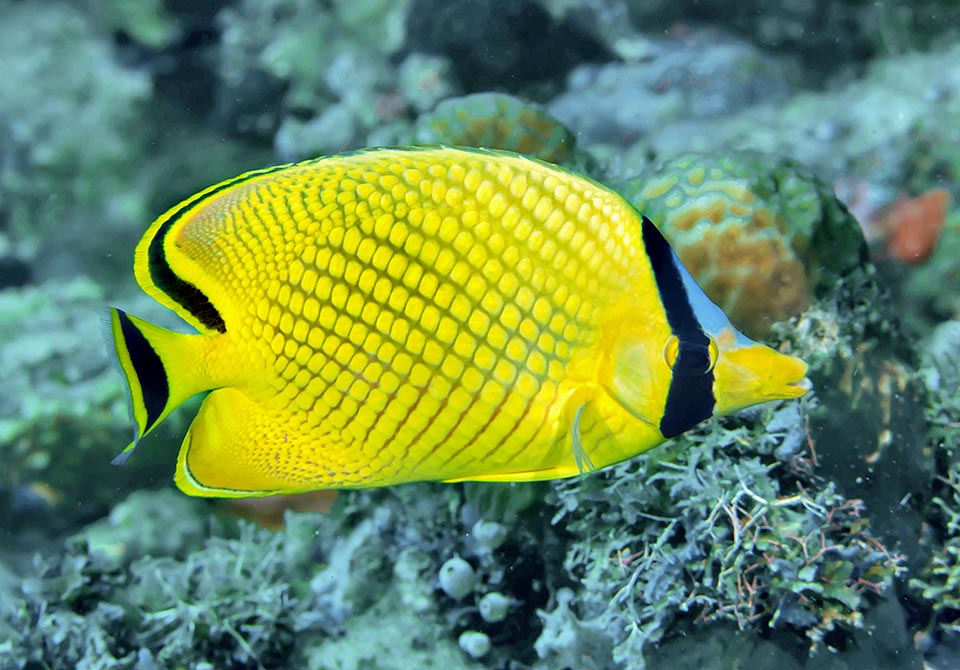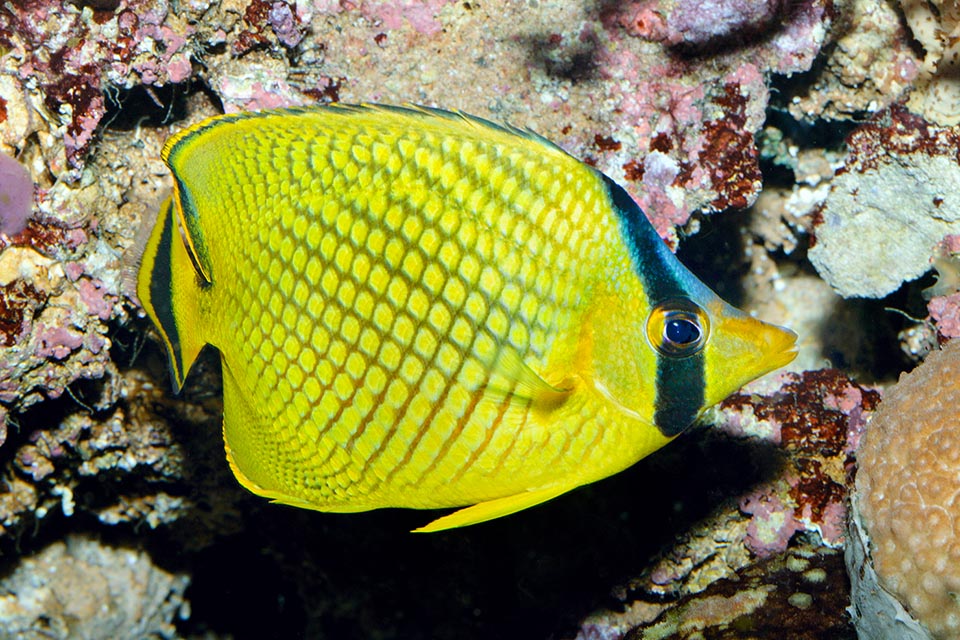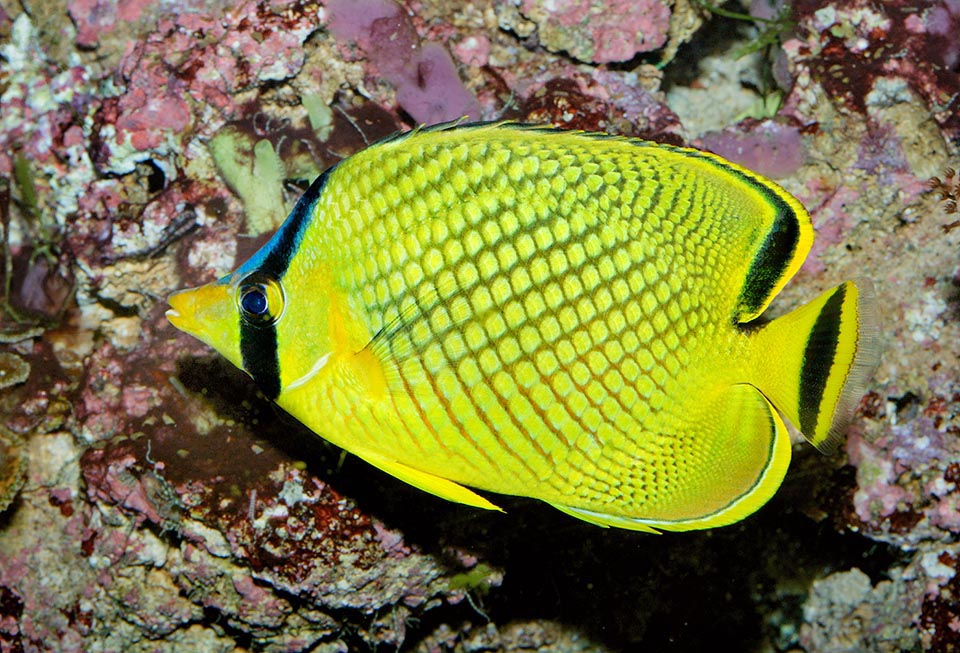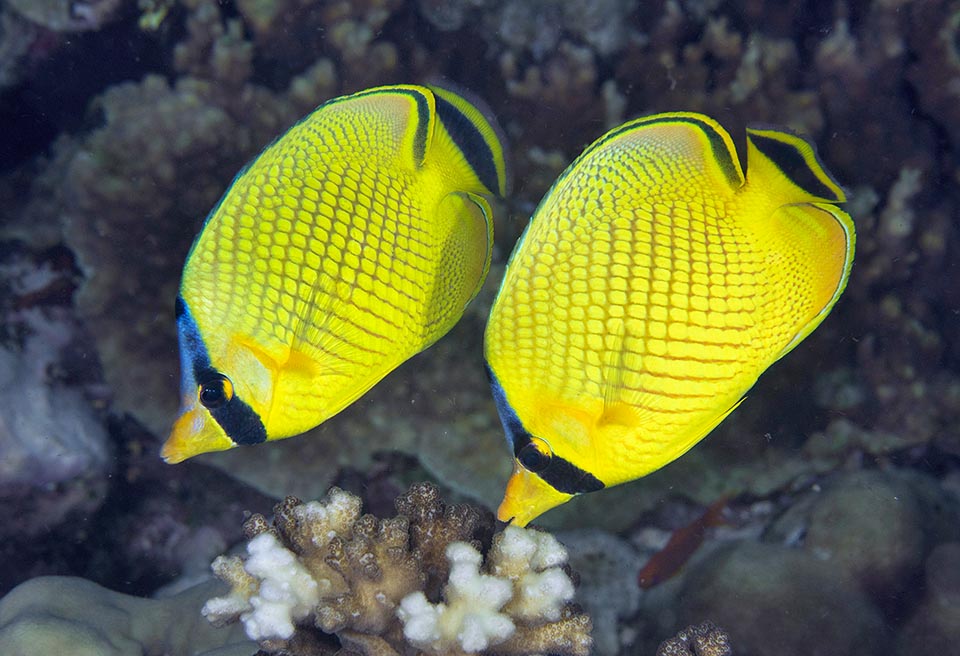Family : Chaetodontidae

Text © Giuseppe Mazza

English translation by Mario Beltramini

The Latticed butterflyfish (Chaetodon rafflesii) is an uncommon species but with a vast diffusion in tropical Indo-Pacific, from Sri Lanka to Tuamotu Islands © Rickard Zerpe
The Latticed butterflyfish (Chaetodon rafflesii Bennett, 1830) belongs to the class of the Actinopterygii, the ray-finned fishes, to the order Perciformes and to the family of Chaetodontidae.
The name of the genus Chaetodon comes from the Greek “χαίτη” (khaite), hair and “ὀδούς” (odous), tooth, due to the “bristle-shaped teeth”.
The name of the species rafflesii is a tribute to the memory of the British politician, military and colonial administrator Thomas Stamford Raffles (1781-1826) who founded the London Zoological Society and the city of Singapore, taking interest in the flora and fauna of Malaysia and Java.
Zoogeography
It has a very vast distribution in the tropical waters of the Indo-Pacific.

15 cm long, with an 18 cm record, lives on the edge of the reefs, not beyond the 15 m of depth, mainly eating polyps of madrepores, sea anemones and polychetes © Giuseppe Mazza
We find it in Sri Lanka, Thailand, Australia, Indonesia, New Guinea, Micronesia, New Caledonia, Vanuatu Fiji, Tonga, Tahiti and eastward up to the Tuamotu Islands archipelago. It reaches, northwards, the Philippines, Taiwan, China and southern Japan.
Ecology-Habitat
Not very common, it lives in shallow waters and along the borders of the reefs, among the madrepores rich in caches, up to 15 m of depth. It is, at times, also present in brackish waters.
Morpho-physiology
The Latticed butterflyfish can reach the 18 cm, even if rarely it exceeds the 15. The body is flat, more or less oval, with pointed snout for seizing the food among the corals.

The dark border of the scales forms a mimetic reticle. The black band with blue edge hides the head, whilst the parallel one on the tail simulates it, confusing predators © Giuseppe Mazza
The dorsal fin has about 12-13 spiny rays and 21-23 soft; the anal has 3 spiny rays and 18-20 soft; the ventral and the pectoral ones are unarmed; the caudal fin is more or less blunt.
The colour of the body is yellow, with greenish shades, and the dark border of the scales forms a sort of network with nodes.
A black band, edged up of blue so as to cover the front, hides the eye, and a black pattern is present also on the tail and the back part of the dorsal fin.
During the night, the colour of the body fades and becomes almost white, whilst a showy dark spot appears in the fore part of the back, and also the frontal blue darkens. This is a mimetic pyjama and a warning, well visible in the darkness, for the conspecifics.
The juveniles are completely yellow with a black band on the eye.

It lives solitary or paired. The fecundated eggs are entrusted to the currents and the species, little fished and with good resilience, is not endangered © Mark Rosenstein
Ethology-Reproductive Biology
The latticed butterflyfish is carnivorous, but with a varied diet. It doesn’t nourish only of polyps of madrepores and corals, but also of sea anemones, polychetes and other benthic animals.
It lives solitary or paired, especially during the reproductive period, when, after the fecundation, the eggs are entrusted to the currents.
The populations may double n less than 15 months and, aquaria trade apart, it is not chased by the man because it does not have any value as food. Consequently, its vulnerability index is very low: only 10 on a scale of 100.
Synonyms
Chaetodon dahli Ahl, 1923; Chaetodon princeps Cuvier, 1831; Chaetodon sebae Cuvier, 1831.
→ For general information about FISH please click here.
→ For general information about BONY FISH please click here
→ For general information about CARTILAGINOUS FISH please click here.
→ To appreciate the BIODIVERSITY of BONY FISH please click here.
→ To appreciate the BIODIVERSITY of CARTILAGINOUS FISH please click here.
